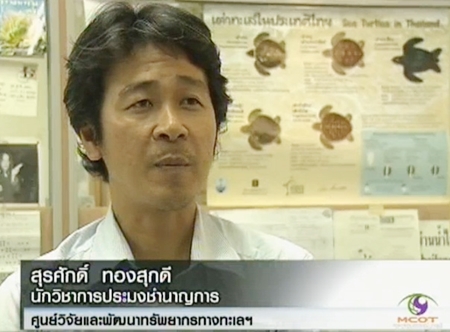A baby Bryde’s whale was recently spotted in the Gulf of Thailand after separating from its mother for a long time. The sighting brought joy to a group of researchers who spent years tracking the young calf’s trail.
Minister of Natural Resources and Environment Wichet Kasemthongsri led a group of researchers inspecting the Tha Chin River near where Samut Sakhon and Samut Songkram provinces, connect southwest of Bangkok, to see the lives of Thailand’s Bryde’s whales.

One Bryde’s whale was spotted during the trip. Researchers on the boat recognised it was ‘Somtum’ (‘Papaya Salad’), a more than two-year-old whale with a dented dorsal fin. Its discovery this time provided key information, as it was the first time since October last year that Somtum was spotted alone without its mother.

A Bryde’s whale baby stays with its mother for two years before they go their separate ways.
Minister Wichet said it was delightful that this mammal was sighted again in Thailand. Enthused, he said he wishes to promote more research on Bryde’s whale preservation along with tourism.

“We will support provincial offices, particularly provincial organisation units, to cooperate with the ministry to remodel unused fishing boats to become boats for tourism,” Natural Resources and Environment Minister Wichet Kasemthongsri.

The Marine and Coastal Resorces Department has been studying the life cycle of Bryde’s whales for almost four years. Once a new whale is discovered, the department’s officers will record its exact location, skin flaws and behaviour.
As a result, so far about 40 Bryde’s whales have been named and categorised.

According to the animal’s nature, its appearance alone cannot indicate its sex. A female Bryde’s whale is easily recognised only by having its baby swimming alongside it. There are only eight females out of the total 40.
Surasak Thongsukdee, academic and fisheries expert from the Marine and Coastal Resources Research and Development Center (Upper Gulf of Thailand), explained the behaviour of a mother Bryde’s whale and its baby.

“A female Bryde’s whale is pregnant for 12 months and will feed its baby for six months. After this period ends, a baby whale will live with its mother for another two years so as to learn food-hunting skills. From our record, shortly after a baby whale leaves its mother, she will give birth to another baby, which means she can become pregnant at the same time as raising a baby,” Mr Surasak said.
In the future, researchers need to study the food-hunting directions of Bryde’s whales by setting up a satellite monitoring system. According to past surveys, the marine animal cannot be found in Thai waters in some periods of the year. Hence, it is possible that the whales swim out of the Gulf of Thailand to nearby areas and later return.
Four Bryde’s whales were born this year. ‘Hin-Aim’ is the latest whale spotted last month.
Spotting many Bryde’s whales in the country reflects the richness of the Gulf of Thailand where food is abundant for the whales.
Authorities said in the future, naming baby whales will be promoted among Thais in order to have them participate in the lives of the whales and to foster the good awareness among the public regarding whale conservation.




